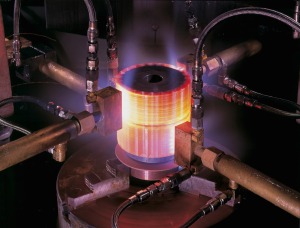Goldilocks Knows Her Heat Treating… “Just Right”

Heat treating metals all involve getting it “not too hot, not too cold, but just right” for the resulting hardness level to meet specifications. Although it may appear like trial and error to achieve hardness levels matching the spec, I hope you see from these blogs that we actually know what to adjust in the heat treating cycle, particularly when using flame, to adjust your hardness levels to meet specs.
Today’s blog talks about how to reduce hardness levels when the part is coming in above the maximum level required by the heat treat spec. You would think most people deal with the problem we explored in the last post, that of not achieving the specified hardness levels. But we actually see this opposite problem a fair amount in the field. Not everyone wants to harden to a level that a composite can achieve in its ideal state – usually because they intentionally want this part to take more wear and tear. If it can be replaced more easily than the part that it’s working against, a part may be designed to be softer than the maximum allowed hardness for its material.
It also happens that some folks don’t even know why they want a particular hardness level. We very often find that at some point in the past, some designer or engineer decided that’s the hardness level and the composite they wanted. Once that particular part is in the field, they become a known quantity, so anything out of that range does not meet spec. Sometimes we do ask clients why they are using particular hardness levels and particular materials, just to be sure we aren’t dealing with a legacy that no longer fits the present production requirements.
But let’s assume the specified hardness level is correct for the application and you are coming in too high. For example, let’s say you are hardening 1045 crane wheels to their ideal maximum, 60 Rockwell; but the spec requires 50 Rockwell. You might think you would just heat the 1045 to a lower temperature than the ideal, but remember our little saying “It’s not just the heat, it’s the cool.” You ALWAYS want to heat your material to the temperature that creates its ideal Austenizing state. That gives you the best structure in the steel. Then, to reduce hardness points, adjust the quench cycle. In the crane wheel example, we heat the 1045 to 1500 degrees achieve the ideal state, which in a typical quench cycle would produce 60 Rockwell. To achieve Rockwell in the low 50’s we quench the wheel until it reaches 500 degrees then bring it out of the quench and let it cool by air. Remember, slower cooling cycles temper the steel, in this case enough to lower the hardness level to the lower 50s.
So the best way to reduce your hardness levels, especially when you want the level lower than the material can achieve, is to heat the steel to its ideal state, then temper it back from that to create the best structure the steel can be in.
As always with heat and cooling, mass and material matter. We’ve seen customers with large steel rolls made of a high alloy composite simply eliminate the quench and air cool the rolls entirely to get the steel to the Martensite level they want. Just remember that to reduce hardness points, increase the length of your cooling cycle according to the mass and material you’re dealing with. If the part has smaller mass and does need a quench, you can lengthen the quench cycle itself by adding more polymer to the tank. The more water in the quench, the faster it cools – the harder your levels will be. (You can also increase the temperate of the quench to slow down the cooling, but we rarely see that method used.)
Once we start blogging more about design, I will explore various quench materials such as water, polymers and oil and get into the details about the properties of each. But I hope this blog helps you become better acquainted with the uses of quench and cooling to reduce hardness points, without compromising the structural integrity of your steel or cast iron. As always, if you want to ask me to cover a specific heat treating topic or anything related to flame hardening as well, email me at mark@flametreatingsystems.com or call 919-956-5208. Happy heat treating – and quenching!
B6: We want to know your opinion.






